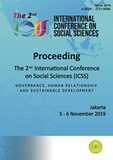E-KELURAHAN AS DIGITAL BASED SERVICE IN PANCORAN MAS
Abstract
Depok City Government as one of the 10 Cities, in 2017 received awards with the best national performance from the 542 Autonomous Regions to continue to develop e-Government, one of which is through the e-Kelurahan program, which is a system that can process all licensing in the kelurahan. The licensing process in the kelurahan can also be directly connected to the Kecamatan. With reports coming into the District, it can avoid cheating. Because based on information from the District Head quoted from the Depok News page (https://www.depok.go.id/09/01/2017/01-berita-depok/ uploaded March 7, 2018: 20.43 WIB), before the use of the system e-Kelurahan, there are illegal levies in the licensing service process by rogue employees, where employees cheat by agreeing to the licensing process without the conditions for completing licensing service procedures. Before the application of e-Kelurahan is the lack of human resources in administrative services in the Kelurahan, so services tend to be long and lack of information that can be conveyed to the community. this study aims to look at the implementation of e-Kelurahan in Pancoran Mas, Depok and see the supporting and inhibiting factors. The method used is a Qualitative Approach with Descriptive Analytical Research Type. The results of this study were seen using e-government implementation indicators put forward by Richardus Eko Indrajit, namely: 1) the condition of the infrastructure data on the application of e-Village is internet-based which provides services for more than 30 letter templates that are carried out online, and even document documents through scans and citizen data are automatically stored in the Kelurahan archive. 2) Availability of legal basis, the implementation of e-Kelurahan is part of the implementation of the Depok City smart city, and the application in Kelurahan is supported by standard operational procedures, which in principle are SOPs that are derived in service with online systems. 3) Coordination between agencies, e-Kelurahan is the result of collaboration between Disdukcapil and Telkom, which is implemented in Pancoran Mas Sub-District and 6 Kelurahans, so that the system is integrated between the Sub-District and Kelurahan under the Pancoran mas Sub-District. 4) The availability of the apparatus, HR is an important part in the application of e-Kelurahan, but Pancoran Mas Kelurahan has not done a lot of HR update in the application of e-Kelurahan. 5) Availability of technological facilities, the system used is sufficient to represent quality services for the community, but due to socialization that has not been optimally carried out, so this service technology has not been implemented properly. 6) Strategy thinking of e-Kelurahan leaders is one of e-Government products in addition to citizen applications (e-residents) and e-Kecamatan.Keywords: e-Government, e-KelurahanReferences
Indrajit, Richardus Eko. 2004. E-Government Strategi Pembangunan dan Pengembangan Sistem Pelayanan Publik Berbasis Teknologi Digital. Andi Offset. Yogyakarta.
Jogiyanto HM. 1993. Analisis dan Desain Sistem Informasi. Yogyakarta: Andi
Mark Forman,. E-Government: Using IT to Transform the Effectiveness and Efficiency of Government.,2005
O’brien ames A. 2 . Pengantar Sistem Informasi: Perspektif Bisnis dan Manajerial. Jakarta: Salemba Empat Offset.
W. Bennis. and M.Mische,. The 21 Century Organization. Pfeiffer&Company.NewYork, 1995
Tjiptono, Fandy. 2003. Strategi Pemasaran. Edisi Kedua.Yogyakarta: Andi Offset.
McLeod. Raymond. 1998. Management Information Sitystems.7th Edition, New Jersey: Prentice Hall, Inc.
Kroenke, D.M., 1992. Management Information System. Watsonville: Mitchell McGraw-Hill
Moenir, 1995. Manajemen Pelayanan Umum di Indonesia. Jakarta: PT Bumi Aksara.
Turban, Efraim; McLean, Ephraim; dan Wetherbe, James (1999).Information Technology for Management. New York: John Wiley & Sons, Inc.
Davis, F.D. 1989. Perceived Usefulness, Perceived Ease of Use and User Acceptance of Information Technology. MIS Quarterly.
Wilkinson, Joseph W. 1997. Sistem Akunting dan Informasi, Edisi 3, Binarupa Aksara, Jakarta.
Amin Wibowo, Muhammad Fakhri Husein 2000. Sistem Informasi Manajemen.
Naisbitt, John. 1994. Global Paradox. New York: Morrow dalam www.naisbitt.com/bibliography,
Winarno, Wing Wahyu, 2004Sistem Informasi Manajemen,Yogyakarta, UUP (Unit Penerbit dan Percetakan) AMP YKPN
Sutabri, Tata .2005.Sistem Informasi Manajemen.2005. Jakarta.
DeLone, WH., dan McLean, ER. 1992. Information Systems Success: The Quest for the Dependent Variable. Information System Research, 3(1), 60-95.
Igbaria, M., N. Zinatelli, P. Cragg, dan A. L. M. Cavaye, (1997), “Personal Computing Acceptance Factors in Small Firms: A Structural Equation Model”, MIS Quarterly, 21/3: 279-305.
Website: www.kemendagri.go.id/news/2017 diunduh 07-03-2018:22.23
https://www.depok.go.id/09/01/2017/01-berita-depok/ diunggah 07 Maret 2018:20.43 wib


